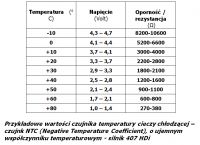krzysztofx2 wrote: On the computer test, after warming up the engine, the computer shows the engine temperature of 67 degrees. By contrast, the car clock is 80 degrees. And now I don't know where it shows the true temperature.
It is best to check the temperatures according to the meter and computer during the first morning start-up, when all temperatures are the same and are equal to the ambient temperature (compare e.g. with a thermometer outside the window).
If differences emerge between
coolant temperature sensor and with a thermometer outside the window - the sensor is faulty and should be checked more carefully. Because if it raises the temperature as you do (+ 80 degrees C instead of + 67 degrees), you may have trouble starting the engine when the frosts come.
The point is that the control computer is giving
starting dose of fuel always based on the temperature of the analog NTC coolant sensor. if it's
low temperature liquid (and engine) - gives
large starting dose . If the engine is
warm - he says
small starting dose , etc.
Of course, the word "gives" is arbitrary, because the computer directly controls the electrically injectors by sequential current pulses to the electromagnetic coils or piezoelectric actuators at the top of the injectors (
Common Rail ).
Examples of signal values sent to the computer by the coolant temperature sensor (thermistor) are shown in the table below.

When really frosts come, the computer will not know that the engine is very cold, only hot, because it has a sensor temperature of + 80 degrees C. And then problems with starting and heating the glow plugs will begin, despite the impeccable condition of all starting elements. This is only because the deceived computer gives too little fuel to the injectors.
And all because only one sensor is faulty, which increases the temperature (e.g. due to moisture).
Kisses KotBury2



